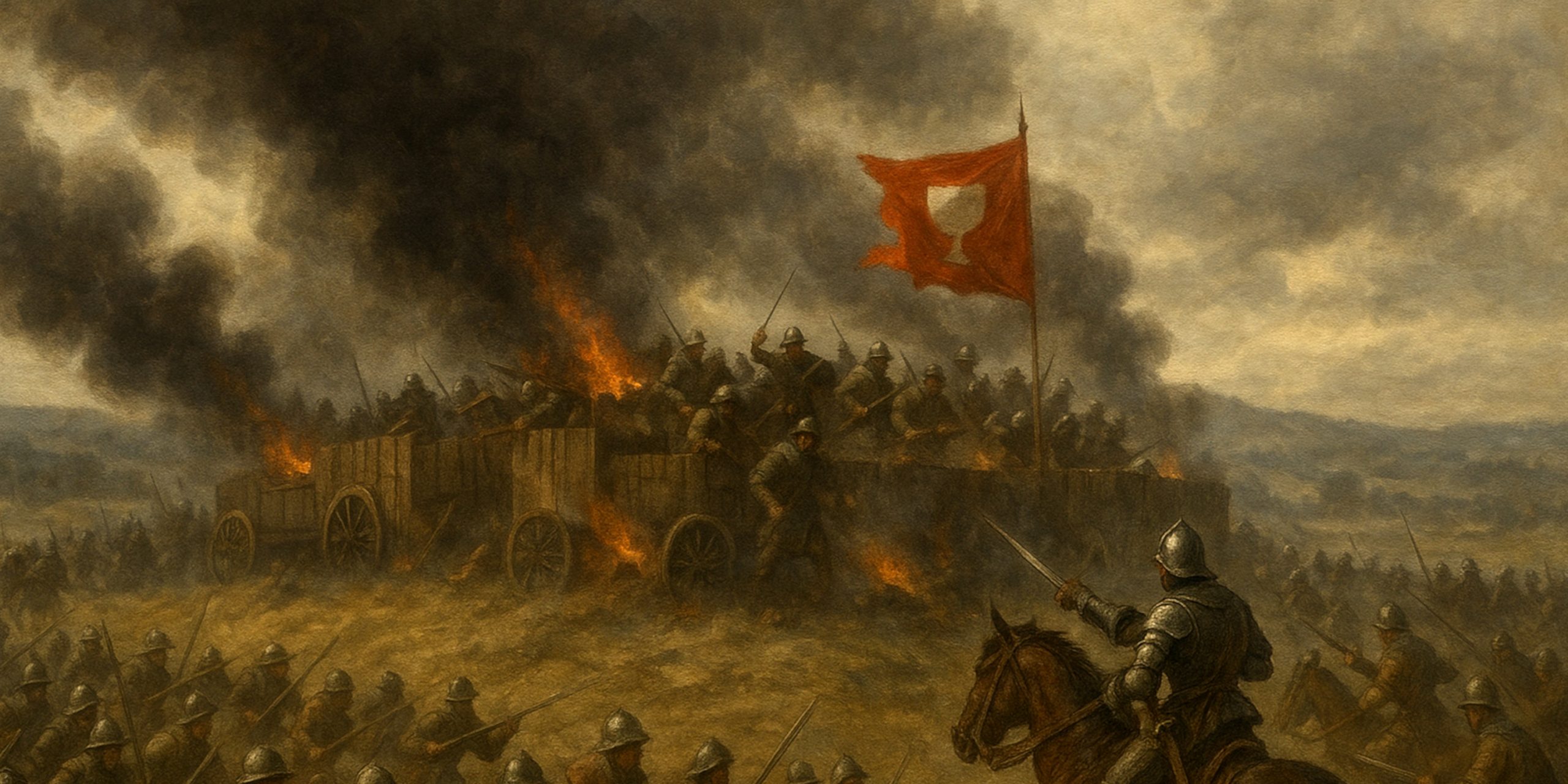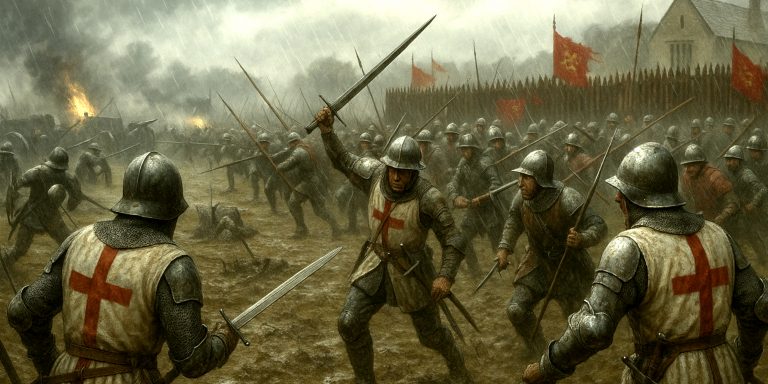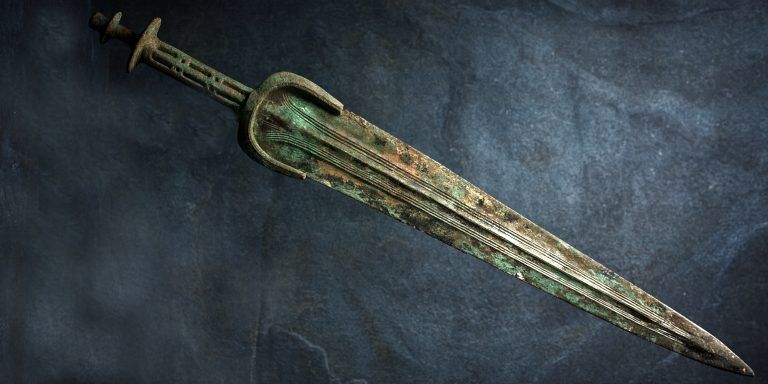
The Battle of Lipany in May 1434 was the final act in the Hussite Wars, fought between the radical Taborites and their more moderate compatriots, the Utraquists, allied with Catholic nobles. It was not only a military engagement but also a decisive moment of political theatre. The Hussite movement, which had shaken Christendom for more than a decade, ended with a sudden collapse at the hands of its own supposed brethren.
If nothing else, Lipany shows how revolutions often end not with external conquest but with betrayal from within.
Forces
The battle lines were drawn between two factions that had once marched together under the chalice banner.
Taborites and Orphans (Radical Hussites):
- Leaders: Prokop the Great, Prokůpek, and Jan Čapek of Sány
- Strength: Around 10,000 troops, including battle-hardened veterans who had routed crusading armies before.
- Composition: Wagenburg (wagon fort) tactics, armoured infantry, war wagons with mounted guns, crossbowmen, and a strong core of disciplined pikemen.
Utraquists and Catholic Nobility (Moderates):
- Leaders: Diviš Bořek of Miletínek, Menhart of Hradec, and Oldřich of Rožmberk
- Strength: Roughly 12,000–13,000 troops.
- Composition: Heavy cavalry drawn from the nobility, infantry levies, mercenaries, and enough artillery to batter down the Taborite position.
Leaders and Troop Composition
| Side | Leaders | Troop Strength | Core Units |
|---|---|---|---|
| Taborites & Orphans | Prokop the Great, Prokůpek, Jan Čapek of Sány | ~10,000 | Wagenburg, crossbowmen, pikemen, field artillery |
| Utraquists & Catholics | Diviš Bořek, Menhart of Hradec, Oldřich of Rožmberk | ~12,000–13,000 | Heavy cavalry, infantry levies, artillery, mercenaries |
Arms and Armour
Both sides drew on a mix of late medieval weaponry, but the radicals leaned heavily on the ingenuity of their war wagons.
- Taborites and Orphans:
- War wagons mounted with small cannon and crossbows.
- Polearms such as guisarmes and halberds.
- Swords included arming swords and falchions, suited for brutal close fighting once the enemy broke into the wagon line.
- Armour: Mostly brigandines, kettle hats, and mail, with some plate for commanders.
- Utraquists and Catholics:
- Heavy cavalry wielding longswords and lances.
- Infantry with crossbows and pikes.
- Knights favoured longswords, with some carrying specialised thrusting swords such as estocs to pierce armour.
- Armour: Full plate for nobles, padded jacks and partial mail for levies.
The contrast was stark: professional soldiers of fortune and armoured knights against wagon-fort tacticians.
The Battle
The radicals entrenched themselves in a wagon fort on the hills near Lipany, a tactic that had humiliated crusaders for years. The moderates staged a clever ruse: a feigned retreat that lured the Taborites into abandoning their defensive position. It was the military equivalent of getting a chess opponent to throw away their queen.
Once the radicals left the safety of their wagons, the moderates’ cavalry charged and artillery fire shredded their lines. The rout was merciless. Prokop the Great and many of his fellow commanders were killed. Thousands of radicals were cut down or burned alive as the wagon fort was stormed.
Archaeology
Excavations around Lipany have uncovered:
- Arrowheads and crossbow bolts, consistent with Hussite tactics.
- Burnt remains of wagon fittings, suggesting the final storming was accompanied by fire.
- Fragments of plate and brigandine fittings, evidence of both noble cavalry and radical infantry equipment.
While no grand relic has been found to rival the sword of a king, the site speaks to the brutality of fratricidal conflict. The charred iron tells the story more honestly than the chronicles.
Battle Timeline
- Early May 1434: The moderate coalition gathers strength and marches to confront the radicals.
- 29 May 1434: Both armies meet at Lipany.
- Morning: Taborites set up their wagenburg on high ground.
- Midday: Utraquists feign retreat, drawing the radicals out from their defences.
- Afternoon: Moderate forces counter-attack with cavalry and artillery. The wagenburg collapses.
- Evening: Thousands of Taborites killed; Prokop the Great falls in battle.
Contemporary Quotes
The chronicler Laurentius of Březová, sympathetic to the radicals, wrote:
“There the chosen people of God were abandoned to slaughter, deceived not by pagans but by their own brethren.”
On the other side, a Catholic noble noted with grim satisfaction:
“The chalice was not cast down by emperors nor by popes, but by the hand of its own servants.”
As one can tell, medieval chroniclers did not go in for understatement.
Legacy
Lipany marked the end of the radical phase of the Hussite Wars. The moderates reached a settlement with the Catholic Church, securing Utraquist communion under both kinds. The Taborite dream of a wholly reformed Christendom was extinguished in fire and blood.
It is tempting to see Lipany as yet another case of “revolution devours its children,” but it was also a cold reminder that unity in ideology rarely survives the practicalities of politics. The Hussites who once faced down Europe’s crusaders met their end at the hands of countrymen, proving that betrayal, not battle, often shapes history.
Watch the documentary:



